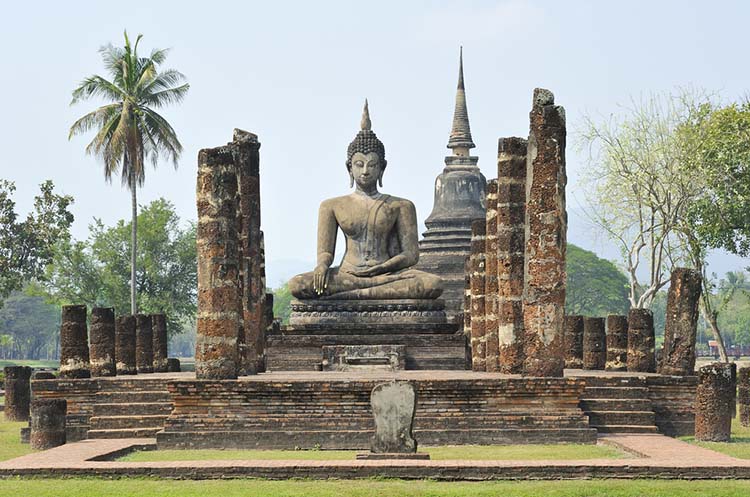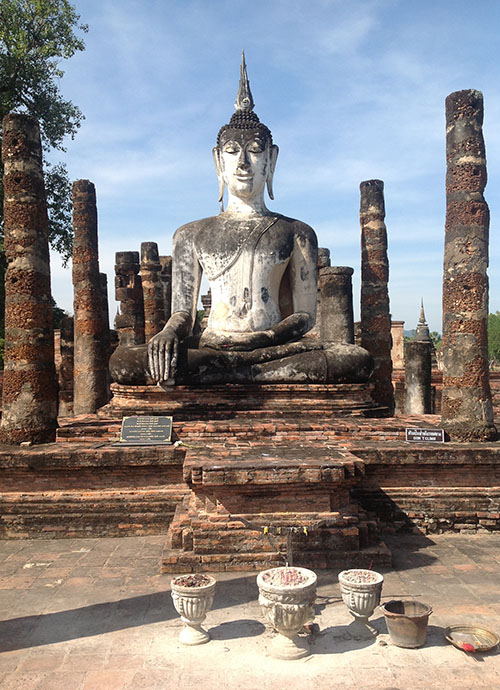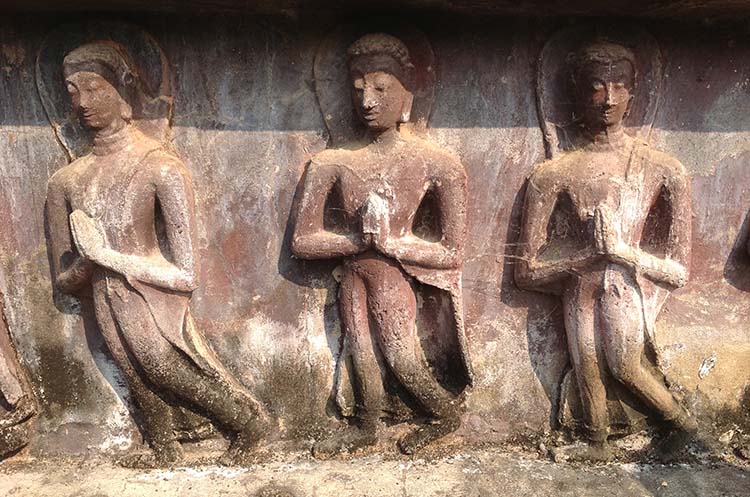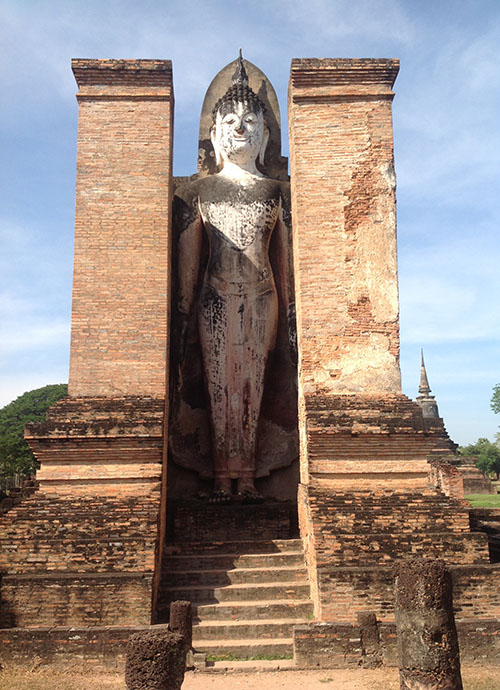
Wat Mahathat
Temple of the Great Relic
The Wat Mahathat is located in the central zone of the Sukhothai Historical Park in the center of the old walled town. It was the largest and most important temple of the empire, located next to the Royal Palace.
The temple’s name translates to “temple of the Great Relic”. The temple was built following the concept of Mandala, an ancient Hindu symbol representing the universe.
The Wat Mahathat was founded by Sri Indraditya, the first King of the Sukhothai empire in the 13th century. A small temple at fist, it was enlarged and renovated several times by later Kings.
Lanna, Singhalese, Sukhothai & Mon Hariphunchai styles
The temple surrounded by a moat and brick walls contains a great number of monuments including the main lotus bud chedi, numerous more chedis in several styles, viharns, an ubosot and three mondops enshrining large images of the Buddha.
Because structures were added over the course of several centuries, the temple grounds contains structures of several architectural styles including Lanna, Singhalese, Sukhothai and Mon Hariphunchai.

The Ramkhamhaeng stele that provided a wealth of information about the great King Ramkhamhaeng and the history of both the Sukhothai empire and the Wat Mahathat was found at this temple.
The main chedi
The main chedi stands on a square platform surrounded by smaller chedis. It was built in 1345 to enshrine relics of the Buddha. The chedi is topped with a finial shaped as a lotus bud, characteristic for the Sukhothai architectural style.
Its base is adorned with 168 stuccoed sculptings of walking pilgrims and monks. Over the walking pilgrims are niches containing images of the Buddha in various postures, including a walking Buddha in Sukhothai style. The upper part of the main chedi is adorned with stuccoed reliefs of scenes from the life of the Buddha.

The main chedi is surrounded by eight smaller chedis, of which the four at the corners are in Mon Hariphunchai style and the four in between show Khmer influence.
The Mon Hariphunchai style chedis are in the shape of a stepped pyramid with receding tiers in which are rows of niches on all four sides that enshrined images of the Buddha. The chedi resembles the Mahabol chedi of the Wat Ku Kut in Lamphun, one of the few surviving examples of Mon Hariphunchai architecture in Thailand.
The main viharn
In front of the principal chedi stand the main viharn or assembly hall of which the base and several rows of pillars remain. The viharn enshrined a bronze seated image of the Buddha in the Bhumisparsha mudra, also known as “subduing Mara” or “calling the Earth to witness”. Stone inscription number 1 mentions a bronze Buddha image that was enshrined in the principal viharn in 1362.
During the reign of King Rama I in the late 18th century the image was moved to the Wat Suthat in Bangkok where it was named Phra Sri Sakyamuni.
Other structures of the Wat Mahathat
Very large images of the Buddha were popular during the Sukhothai era. Two mondops flanking the main chedi enshrine a 12 meter tall standing Buddha image known as Phra Attharot. Another mondop contains a large stuccoed image of the Buddha in meditation mudra, seated on a pedestal.

A large chedi enshrines the ashes of Phra Maha Dharmaraja Li Thai, one of Sukhothai’s Kings. The base of another large chedi is adorned with stuccoed figures of elephants and devil like creatures. Near the main viharn is a smaller viharn built during the Ayutthaya period. It contains a large seated image of the Buddha.
Other structures on the grounds include an ubosot or ordination hall containing a seated Buddha image in the Bhumisparsha mudra, several viharns and about 200 small chedis in various states of preservation.
- Wat Si Sawai
- Wat Sa Si
- Wat Sorasak
- Wat Tra Phang Ngoen
- Wat Si Chum
- Wat Chetuphon
- Wat Phra Phai Luang
- Wat Saphan Hin
- Private or group tour
- Full day tour from Sukhothai
- Explore historical park & countryside by bike
From Chiang Mai
- Private or group tour
- One day or multiple days tour from Chiang Mai
- Explore historical park & countryside by bike